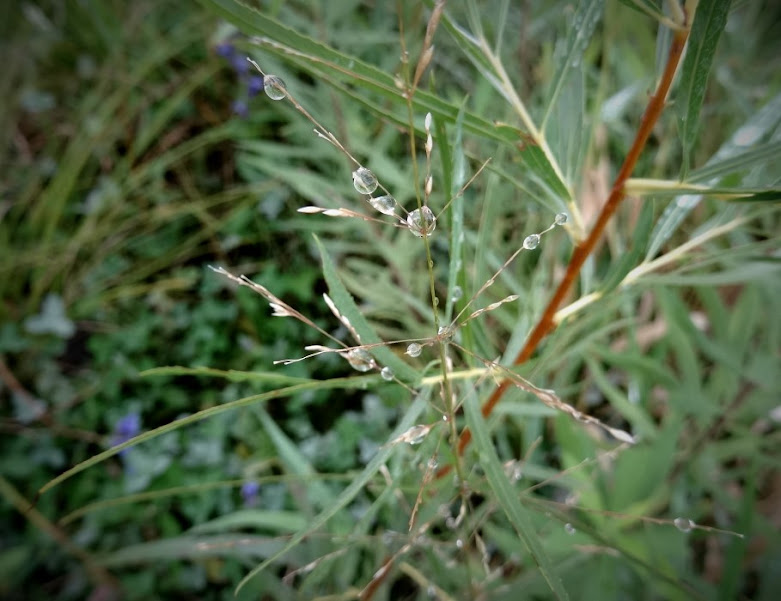This wildflower was finished blooming and was forming seeds. But its seed head sprouted green leaves! Fascinated, I looked closer. Some of new seeds were actually germinating and sprouting while still in the seed head. Usually, they wait until they are in the perfect place (soil, moisture, temperature, sunlight) to begin new growth. Sometimes you see this while seeds are still inside the fruit, like a tomato or green pepper. In plants, it is called vivipary (Latin for 'live birth') and involves seeds germinating before their determined time. I first learned about this a few years ago when my grandson sent me a photo of a sunflower seed head that was doing the same thing.
Showing posts with label unusual. Show all posts
Showing posts with label unusual. Show all posts
9/06/2022
9/12/2020
7/16/2020
Ironweed ready to bloom
Ironweed Vernonia fasciculata is growing tall in the buffer around the pond. Soon, it will open its brilliant purple aster-like flowers in clusters at the top of each regal plant. The name 'Ironweed' becomes this plant because the stem is tough, straight, and strong, up to 6 feet tall. It is very attractive to butterflies and native bees, and is a host plant for the American Painted Lady butterfly.
In the photo below, you can see the upper 12 inches of a six-foot tall specimen with flower buds.
In the photo below, you can see the upper 12 inches of a six-foot tall specimen with flower buds.
2/18/2017
swallowtail
This beauty was in my studio this morning!
I collect plant specimens in the autumn and keep them to draw or paint indoors during the cold months. I recall pulling this chrysalis off the deck umbrella a few months ago, and placed it among the interesting things in my art room.
8/20/2016
Indianpipe
 Indianpipe Monotropa uniflora is white because it contains no chlorophyll; it derives water and other nutrients by tapping into the thread-like
cells of the vegetative part of soilborne mycorrhizal fungi.
Indianpipe Monotropa uniflora is white because it contains no chlorophyll; it derives water and other nutrients by tapping into the thread-like
cells of the vegetative part of soilborne mycorrhizal fungi.It appears in forests, scattered, and uncommon. It will grow near a narrow range of mushrooms in the Russulaceae family. We saw this on a field sketching day in a nearby remnant of Big Woods.
Indianpipe is also called Ghost Plant or Corpse Plant.
12/07/2015
winter blooms
This winter is slow to chill Minnesota. The "trumpet vine" Lonicera 'Major Wheeler' is still blooming! Not just hanging-on old blossoms, but fresh blooms. Usually, the entire vine has dropped leaves and spent blossoms by now. This autumn, El Niño has brought consistent warm mid-40's weather instead of several hard freezes.
 |
| photo taken December 6, 2015 |
11/02/2015
November blossoms
Warmer-than-average weather this autumn! Many perennials are still standing and even blooming in the gardens and woods.
The raspberries are still going strong; several canes are blooming with vigor as if it is August.
1/20/2014
eye shields
I've occasionally noticed something about the eyes on some of the birds I observe: milky or filtered texture.
According to the Cornell Lab of Ornithology http://www.allaboutbirds.org, birds have what is known as a nictitating membrane or “3rd eyelid”.
This membrane is a translucent or clear eyelid, closest to the eyeball. A bird will close these membranes over their eyes but can still see through them to protect their eyes when needed, such as in flight, while hunting, or to dive under water.
This Northern Flicker may have been trying to shield his eyes from flying bits of bark as he probed for insects.
12/24/2012
albino House Finch
At first I thought this little round white bird, roosting early this morning among the House Finches, was an owl. But closer inspection through the binoculars make me think it is an albino House Finch.
7/24/2009
hostas in bloom

The shady front corner is finally established with astilbes and hostas.
In past years I tried a few other plants here but they did not like the situation.
This Spring the astilbes and hostas came up vigorously and seem very happy together.
The "Krossa Regal" Hostas have become huge vase-shaped beauties with blooms on stems nearly as tall as I am.
In past years I tried a few other plants here but they did not like the situation.
This Spring the astilbes and hostas came up vigorously and seem very happy together.
The "Krossa Regal" Hostas have become huge vase-shaped beauties with blooms on stems nearly as tall as I am.
3/22/2009
Subscribe to:
Comments (Atom)








